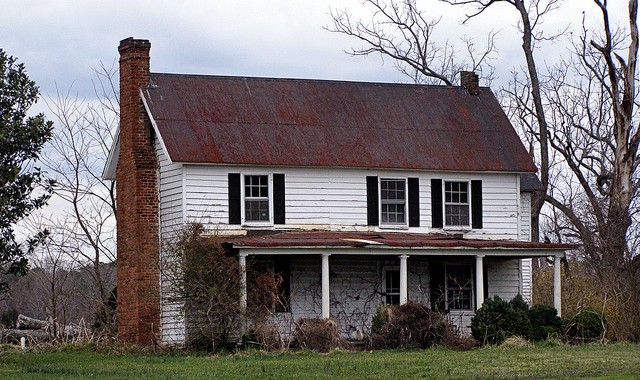
“Dunsville Set: Hickory Grove c. 1893” by Virginia Hill is licensed under CC BY 2.0
There’s a house down the road from me that’s for sale (the one in the photo is not it!). Has been for a long time now. We walk past it 2 or 3 times a week on our way to a baseball field where we play epic games that usually end in gloating (on the winner’s side) and crying (on the loser’s).
Anyway, we do that 2 or 3 times a week and every time I walk past that house–whether I’m on the way to the field with 2 happy boys, or on the way home with one really happy boy and one really sad one–I take a look. And every time I look at it, I think the same thought: “that house sure has a lot of potential.”
And it does. It’s a big stone house–looks like something out of a fairy tale. It’s got a lot of character. It’s near the baseball field (so we could go have our battles EVERY night–hooray!). It looks to be a 4 bedroom, 2.5 bath home. (Which is enticing because my home is currently a 3 bedroom, 1 bath home. And with 5 kids, a wife and myself . . . well, that’s easily 2 bathrooms too few).
So every time I walk past the house, I stop and think about the potential. But every time I stop . . . I start back up and continue on my way home, pushing any thought of buying that house out of my mind.
Oh, it’s not the price. In fact, the price started at the top of our price range (still within it, but at the very top) and it’s dropped $30,000 or $40,000 in price since the beginning of the year. No, it’s not the price. We could afford it if we wanted it. And it’s not really the location. It’s right down the road from our other home and it’s right next to our major evening entertainment–the ball field. It’s definitely not the size of the home: all that extra space and the extra bath and a half would be almost perceived as a gift from heaven.
No. It’s none of those things that keep us away. None of those things that get our legs moving again after we’ve stopped to “window shop.”
No, what gets us moving again is what’s probably kept everybody else moving as well: the house gives a bad first impression.
I’ve never seen much of the inside–not up close anyway–but I’ve got a feeling I know what I’m going to find. See, the outside of a home is a window to the interior. A poorly maintained exterior is a warning many home buyers heed.
We walk up to this house and look at the beautiful aspects: the stone walls, the 4 bedrooms . . . the 2.5 baths. But despite all that, I can’t get past the poorly maintained front door. The overgrown landscaping. The rotting and flaking fences. The windows that are filthy. The blinds that hang crooked and bent.
The one room you can see from the driveway shows that either there was water damage or the family before had a dog. A vicious, baseboard-attacking dog who took out his puppyhood rage on the floor trim of that poor little room.
All in all, despite the nice aspects of the house, the obviously visible negative stuff just turns me off. I’m afraid that something that looks that bad on the outside is only going to be worse inside. And so, every night that we stop . . . we look for a few minutes and continue walking, shaking our heads . . . unable to muster up the interest to call the number on the sign.
Now, I know this house is owned by the bank (or something). It’s empty and has been for a while–so I understand some of the reason for the dilapidated, unkempt look of the exterior. I understand that whoever currently owns it doesn’t want to spend the money or time to keep up on the exterior work. They probably figure it’s too expensive.
However, I can’t help but think that when we started looking, the house was about $179,000. If I’m not mistaken, the current price is either $149,000 or $139,000. It’s dropped anywhere from $30,000 to $40,000 in price and still hasn’t moved.
I’ve written about first impressions here on this blog before. First impressions can make all the difference in the world when it comes to relationships and new jobs. They also play a huge role when it comes to selling a house. Create a great first impression with your home . . . and chances are, even in a down economy, you won’t be sitting on it for too long. Let the importance of that first impression slip down on your list of “things to do” and you’re going to have a situation like the folks who own that house I walk by a couple times a week: you’re going to be lowering your price as you try to make people see past the obvious faults.
When you get to that point: trying to make people see past the faults and focus on the price, you’ve lost your bargaining ground. You want people to want the house because they HAVE to have it–they see themselves living there and can’t picture themselves living somewhere else. When that happens, price becomes a secondary determiner. It’s still important, but it’s not the first thing we check.
When we see a house that shows well, the first thing we do is get out of our car and look around. We imagine our kids playing on the yard. We see ourselves snowblowing the driveway in the winter. We picture cookouts on the grill and all the other fun things that go with life. After that, we cautiously and nervously approach the little info box, hoping against hope that the house is within our range.
On the other hand, when people see the house I walk past every other night, I’d put money on the fact that the only thing they see or imagine is exactly what I imagine: a lot of work. They then probably do what we do and walk straight up to the info box and look at the price.
The big difference between the two scenarios is what happens at the info box: in the first case, we’re looking at the price, hoping it’s within our range. Our heart’s beating a little harder . . . were nervous, excited, hopeful. In the second scenario, none of that’s happening. We’re simply looking to see if the price is low enough to justify any thought whatsoever into purchasing the home.
In the first scenario, if the price is even within $20,000 of your range, chances are you call the realtor–you want to look into it, to dig, to discover if there’s some way you could swing it. You love the house, you want it. Or at least you want to look into it further. In the second scenario . . . if the price isn’t low enough to generate a little interest, you’re walking. You probably stuff that little info slip back into the box with a laugh, or you bring it home and throw it out.
In the first case, the house sells itself–price is of secondary (though still important) consideration. In the second situation, the price is everything: if it’s not low, low, low . . . the first impression of the house doesn’t leave a potential buyer with enough interest to warrant any further consideration.
So all that to say: if you’re trying to sell your home . . . don’t make that mistake. First impressions matter. In the next few posts, we’ll flesh this idea out and I’ll throw out a number of easy, low-cost fixes you can accomplish in a weekend that will help you make sure your house gets people stopping and talking.

